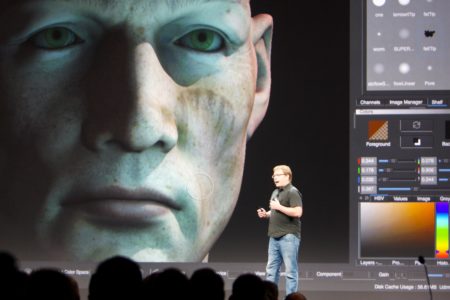Continued from page 1
Higher Hanging Fruit
We just looked at the key low-hanging fruit–cases where a new Mac Pro would almost always make sense. Reaching for the higher fruit always means more work for less return. In this case, we are gauging return on investment (ROI). When you have OpenCL based parallelization involved and extensive or sustained compute-intensive tasks like those in the applications listed in the previous page, the return on investment is rather easy–especially if your billable rate is high.
Many industries and fields have a valuable cost per hour but are quite diversified across applications and workflows. Let’s just start with some of the industries and work through the discussion.
Architecture
The typical architecture firm has a range of individuals doing many functions. Those individuals charged with spending time drafting, modeling and using BIM (building information modeling) applications can vary with role. By in large, nobody spends their entire day in such applications. Typically, staff architects are engaging with other applications like email, project management tools, databases and web browsers, in addition to design tools. As Macworld correctly notes in its review of the new Mac Pro, many of those applications are written exclusively as single-threaded apps and so a higher frequency CPU is more beneficial than a 8 or 12 core CPU like in the Mac Pro. So where do you strike the balance?
If you or your staff are primarily engaged in non-project or office management functions or have dedicated specialities in 3D or rendering–in other words are really pushing their boxes–then consider a Mac Pro if your primary tools benefit from either OpenCL or are highly threaded for multi-core CPUs. Here are some notes:
- ArchiCAD — this leading BIM tool is the most advanced tool in the market for a BIM program that utilizes both background processing and many cores. GRAPHISOFT told us that the new Mac Pro would be very much utilized in ArchiCAD, we are just not sure if the benefit of 8 or 12 cores is truly there versus 4-6 cores. A six core Mac Pro may be the optimal mix of frequency speed and cores for background processing.
- Autodesk Revit — this market leading BIM tool is not native on the Mac but many offices with Macs run it now under Boot Camp. As Boxx Technologies communicated clearly recently, the ultimate Revit machine is a high frequency CPU like the Intel quad-core i7. The 3.7 GHz Quad Xeon in the baseline Mac Pro should be pitted against the top of the line i7-based iMac.
- SketchUp — while not a BIM tool this popular application in architecture is an important mention. SketchUp, we have been told, is CPU-bound and single-threaded and would benefit most from a very high frequency CPU…much like Revit.
- Bentley Microstation — this BIM tool is not much used on Apple hardware. We have no information on whether it is highly threaded or not but an HP-Microstation partner site is pushing the dual-processor based HP Z820 with Xeon processors.
- Vectorworks Architect — this popular CAD/BIM tool mostly benefits from high frequency single-core activity unless it is in active rendering mode via its RenderWorks module.
Of the architectural BIM/CAD solutions just mentioned only GRAPHISOFT ArchiCAD stands out as being clearly benefitting from the many cores available in the new Mac Pro. However, all the apps above would benefit from its super fast next-gen PCIe flash storage.
Industrial and Product Design
Similar to architecture, industrial design shops have a wide variety of roles but in this case we are going to concentrate on the designer and assume a very concentrated use of their workstation needs being centered on high-end tools. There are a wide variety of tools in the professional CAID and product design market but many of the biggest tools like SolidWorks, ProE (Creo) and CATIA are not on the Mac. Siemens’ NX is however is on the Mac.
CAID and MCAD tools are generally powerful 3D systems utilizing OpenGL for their main viewports. Very large assemblies and complex geometries push up against the edge of the performance of the GPU. There is little doubt that the industry’s best tools wouldn’t benefit the most from workstation class AMD FirePro workstation class GPUs. The only question is would the second GPU benefit the setup? Because CrossFire on OS X is not supported we don’t see the second GPU doing much for OpenGL viewport generation until folks like Siemens specifically write NX for Mac for the dual GPU setup. However, the quality of the FirePro-based GPUs may provide the benefit that users have been seeking in the Mac Pro all along–true workstation class GPUs!
Visualization
In our feature on Archiform 3D, Steve Bells makes some good arguments against the new Mac Pro. He’s a CINEMA 4D user and with that program–like most 3D software packages that are CPU-bound, the value of having more cores can be very good, but there is always a trade-off with number of cores and core clock frequency for single-threaded operations. (see image 02)
Mr. Bell makes note that during the rendering and animation parts of the workflow, which can often be many hours long, including up to a day or more, having as many cores to throw at the render job is invaluable. But those slower frequency cores are not helping you with single-threaded modeling and most scene editing operations where a faster frequency CPU would shine.
Unlike Architecture and Product Design, the visualization market workflow often consists of a sustained duration of modeling and scene setup activities and some long burn render and animation times. In the past this is when you would take a long coffee break. There are lots of tools in this space but each user should check with their tool maker to learn just how threaded their application is and for what parts of their workflow. Generally the rendering functions are highly threaded and CPU bound and so multi-processors and multi-cores are valuable.
One negative for the Mac Pro is that it does not come with more than one processor socket. In the PC space you can build a render box with four (4x) 16-core Opteron processors to create a 64-core monster. If viz pros considering the Mac Pro have access to a local network render farm or a remote cloud render solution and like to work that way, then the Mac Pro with either the 4 or 6 core Xeon option might make for a great machine. But take a look at the Blender and Cinebench test results carefully. (see next page).
Entertainment Media
Akiko Ashley’s new Viewpoint article about the Mac Pro in animation and VFX studios is a superb essay into some of the key matters affecting the use of the new Mac Pro in this space. Many of the same issues at hand for visualization 3D pros, like those doing architectural visualization, affect the entertainment media industry workflows as well. Some of the same application packages are utilized.
We do know of at least one E&M software package that has been optimized for the new Mac Pro and that is MARI. Originally developed by director Peter Jackson’s WETA studios and used in the making of the film Avatar, MARI–which is now owned by The Foundry–was showcased at the 2013 Apple WWDC in a special session on the new Mac Pro. (see image 03 below)
MARI for Mac OS X utilizes GPU-accelerated real-time procedural noises, patterns and projections. In the WWDC presentation it was mentioned that MARI was originally designed with multiple GPUs in mind. It was also originally created on the Mac and Linux–not Windows. For Mavericks MARI got updated to support the latest OpenGL and OpenCL 1.2
The way MARI works with the Mac Pro’s dual GPU’s is the Apple template for how the Cupertino company developed its own software to leverage the dual GPUs. Jack Greasley, MARI’s original developer and now with The Foundry, notes in the presentation that they always wanted to leverage one GPU for processing huge amounts of data while the other GPU processes all that data to the display. In the presentation he mentions AMD’s CrossFire and says that CrossFire is fantastic for gamers but that capability has never been available for artists until now.
Apple’s technology for leveraging the dual GPU’s isn’t the same as AMD’s CrossFire technology. There are differences…though we are unclear to their specifics. What we know from AMD is that OpenCL is self-aware of the presence of multiple GPUs and there is no code changes necessary for applications to leverage more than one GPU’s OpenCL capabilities. On the other hand, for OpenGL, application developers need to make changes in their code and specifically target both GPUs.
On the next page we’ll curate many of the best test results to help sharpen your decision making. Do you know if you still need a new Mac Pro or merely want one?
next page: Curated Test Results and Listing






Reader Comments
#CAD The new Mac Pro A Buyer’s Guide Through the Best Test Results http://t.co/vQ0q7E6PLa
#CAD The new Mac Pro A Buyer’s Guide Through the Best Test Results http://t.co/vQ0q7E6PLa
It it worth noting on this day of features on the Mac Pro and its worthiness in various pro 3D fields (Akiko Ashley piece) and this guide to various applications (industries) that we share this post on fantastic demand for the new killer machine! Good news for Apple.
http://www.canadianreviewer.com/cr/2014/2/18/high-mac-pro-demand-pushes-ship-dates-to-april.html?utm_source=feedburner&utm_medium=feed&utm_campaign=Feed%3A+canadianreviewer%2FnPFE+%28Canadian+Reviewer-+News%2C+views+and+analysis%29
It it worth noting on this day of features on the Mac Pro and its worthiness in various pro 3D fields (Akiko Ashley piece) and this guide to various applications (industries) that we share this post on fantastic demand for the new killer machine! Good news for Apple.
http://www.canadianreviewer.com/cr/2014/2/18/high-mac-pro-demand-pushes-ship-dates-to-april.html?utm_source=feedburner&utm_medium=feed&utm_campaign=Feed%3A+canadianreviewer%2FnPFE+%28Canadian+Reviewer-+News%2C+views+and+analysis%29
Apple’s new Mac Pro dual GPU OpenCL architecture incrementally gaining support among developers http://t.co/k951asKIp6
Apple’s new Mac Pro dual GPU OpenCL architecture incrementally gaining support among developers http://t.co/k951asKIp6
RT @DanielEran: Apple’s new Mac Pro dual GPU OpenCL architecture incrementally gaining support among developers http://t.co/k951asKIp6
RT @DanielEran: Apple’s new Mac Pro dual GPU OpenCL architecture incrementally gaining support among developers http://t.co/k951asKIp6
Hi Anthony,
Thanks for the great information. As an architect, I wonder how the more mundane things like navigating a 3D model in SketchUp, ArchiCAD, or Revit in Parallels would or would not benefit from this. I haven’t seen anything out there yet, that really gets into it. I know Revit in Parallels on an i7 iMac with 32MB of RAM is less than stellar.
Hi Anthony,
Thanks for the great information. As an architect, I wonder how the more mundane things like navigating a 3D model in SketchUp, ArchiCAD, or Revit in Parallels would or would not benefit from this. I haven’t seen anything out there yet, that really gets into it. I know Revit in Parallels on an i7 iMac with 32MB of RAM is less than stellar.
Oops, never mind! I missed page 2. Skipped right over it.
Oops, never mind! I missed page 2. Skipped right over it.
[…] materiały na temat wydajności: The new Mac Pro – A Buyer’s Guide Through the Best Test Results I jeszcze jeden – tym razem 6-core 2010+nVidia GTX 680 z 4-core 2013 z 2xD500: Ostatnio […]
[…] <https://architosh.com/2014/02/the-new-mac-pro-a-buyers-guide-through-the-best-test-results/> […]
Comments are closed.